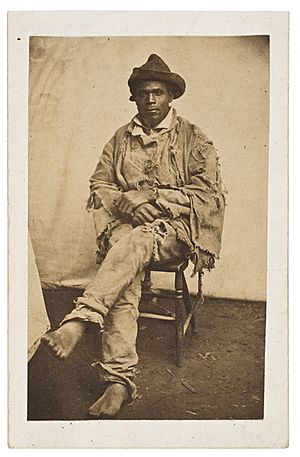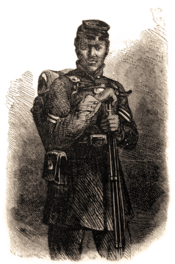Gordon (slave) facts for kids
Quick facts for kids
Gordon
|
|
|---|---|
| Known for | Subject of photos of his scarred back, widely circulated during the American Civil War |
| Military career | |
| Allegiance | |
| Service/ |
|
| Rank | Sergeant |
| Unit | Corps d'Afrique |
| Battles/wars | |
Gordon (active around 1863), also known as "Whipped Peter", was an escaped American slave. He became famous because of photographs showing the severe scars on his back. These scars were from whippings he received while enslaved. The photo of his "scourged back" (meaning a back covered in whip scars) became very well-known. It was shared widely by the abolitionist movement during the American Civil War. This movement worked to end slavery. The photo is still one of the most famous images from that time.
A writer for The New York Times, Joan Paulson Gage, said that images like Gordon's scarred back are still powerful today. She noted they are early examples of how photography could change history. Many historians believe an 1863 Harper's Weekly article was about Gordon. This article included three illustrations and a story about Gordon's escape and joining the Union Army. However, the story might have been made up by Vincent Colyer. It is also possible that Gordon and Peter were two different people.
Contents
Gordon's Escape from Slavery

Gordon escaped in March 1863 from a large plantation. This plantation was owned by John and Bridget Lyons. They held nearly 40 people in slavery. The plantation was located in St. Landry Parish, near the Atchafalaya River.
To hide his scent from bloodhounds, Gordon carried onions. After crossing streams or swamps, he rubbed onions on his body. This helped to confuse the dogs. He traveled over 40 miles for 10 days. Finally, he reached Union soldiers in Baton Rouge.
Meeting Union Soldiers
Photographers William D. McPherson and Mr. Oliver were in the Union camp. They took pictures of Gordon's back. These photos were printed on small cards called carte de visite.
During his examination, Gordon shared his story. He said he had left the plantation ten days earlier. An overseer named Artayou Carrier had whipped him. Gordon said he was in bed for two months because of the whipping. He also said his master later fired the overseer.
Dr. Samuel Knapp Towle, a surgeon, met Gordon. He expected Gordon to be angry because of his scars. But Dr. Towle found Gordon to be "INTELLIGENT and WELL-BEHAVED." Other doctors also saw many backs like Gordon's. They said the photo showed the harsh reality of slavery.
Gordon's Service in the Union Army
Gordon joined the Union Army as a guide. This was three months after the Emancipation Proclamation. This proclamation allowed freed slaves to join the military. On one trip, Confederate soldiers captured Gordon. They tied him up, beat him, and left him for dead. But he survived and escaped back to the Union lines.
Soon after, Gordon joined a U.S. Colored Troops unit. These units were made up of African-American soldiers. The newspaper The Liberator reported that Gordon fought bravely. He served as a sergeant in the Corps d'Afrique. He fought during the Siege of Port Hudson in May 1863. This battle was important because African-American soldiers played a key role in the attack for the first time.
Impact of Gordon's Photos
In July 1863, Gordon's images appeared in Harper's Weekly. This was a very popular magazine during the Civil War. The pictures of Gordon's scarred back showed Northerners the brutal truth of slavery. These images inspired many free blacks to join the Union Army.
Theodore Tilton, an editor in New York, spoke about the photo in 1863. He said the picture should be shared widely. He believed it told the story of slavery in a powerful way. He felt that seeing the photo would make people want to end slavery.
In 2011, James Bennet, editor of The Atlantic, spoke about the image. He noted the "incredible power" of the photo. He also mentioned the "dignity" of Gordon. He said Gordon's pose and expression showed, "This is a fact."
Gordon's Legacy in Popular Culture
- In the 2012 movie Lincoln, Abraham Lincoln's son Tad sees a glass photo plate of Gordon's medical exam.
- American artist Arthur Jafa created a sculpture called Ex-Slave Gordon (2017). It shows Gordon's back from the waist up.
- Emancipation, a 2022 film, is based on Gordon's escape. It stars Will Smith and was directed by Antoine Fuqua.
Gallery
-
This is the 1860 slave schedule for John Lyons' property. Gordon was likely one of the adult male slaves listed here by age.
See also
 In Spanish: Gordon (esclavo) para niños
In Spanish: Gordon (esclavo) para niños



